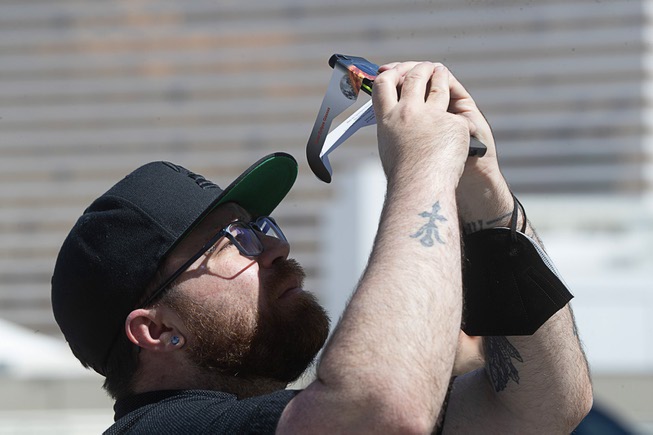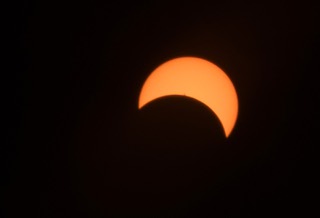
Paul Butterfield uses solar safety glasses over the camera lens of his smart phone to photograph the partial solar eclipse from the top of a Caesars Palace parking garage Monday, April 8, 2024 in Las Vegas.
Monday, April 8, 2024 | 2 a.m.
Las Vegas isn’t on the direct path of today’s solar eclipse, but the partial covering will still be a sight worth seeing, says Francisco Silva, vice president for outreach at the Las Vegas Astronomical Society.
He said Southern Nevada would experience approximately 51% totality with the eclipse — when the moon slides between Earth and the sun to cast a shadow. The partial eclipse as viewed from Las Vegas will last from 10:12 a.m. to 12:30 p.m., with its peak at 11:20 a.m.
“I have seen several of these, yet I cannot explain it in words that make sense,” says Silva, who is also a solar system ambassador for NASA. “Your brain (goes) into a totally different phase and it’s amazing … just a totally amazing experience.”
The total eclipse’s path will begin along Mexico’s Pacific coast, cross into Texas and 14 other U.S. states before exiting over Canada. Totality will begin at 1:27 p.m. CDT in Texas and end at 3:35 p.m. EDT in Maine.
As the eclipse traverses its path of totality, the moon will shroud the sun for up to 4 minutes, 28 seconds directly over two major cities: Dallas and Cleveland. About 44 million people live within the path of totality, with another couple hundred million, including cities such as San Antonio, St. Louis and Detroit, within 200 miles to bring the biggest eclipse crowd ever to North America.
If you want to directly look at the eclipse as it passes over Las Vegas, you will need a pair of protective glasses designed for solar viewing. Silva warns of fraudulent glasses and recommends those meeting infrared light transmittance requirements. (Check for the designation number ISO 12312-2024).
Eclipse glasses are a must to prevent eye damage, scientists at NASA said.
“Except during the brief total phase of a total solar eclipse, when the moon completely blocks the sun’s bright face, it is not safe to look directly at the sun without specialized eye protection for solar viewing,” NASA said. “Viewing any part of the bright sun through a camera lens, binoculars or a telescope without a special-purpose solar filter secured over the front of the optics will instantly cause severe eye injury.”
Jason Steffen, assistant professor of physics and astronomy at UNLV, said there were indirect viewing alternatives to experience an eclipse without purchasing glasses. Take the tinfoil method.
“What you can do instead is you can get a piece of tinfoil and poke a hole in it,” he said. “Then basically, you look at the shadow, the sun will go through the hole in the tinfoil and then you’ll see an image of the sun just projected on the ground in the shadow.”
Steffen has also tried the same method with a colander, in which the eclipse went through it and projected hundreds of small crescent shapes on the ground or canvas.
There is no specific location in Las Vegas that’s better to view the eclipse — Steffen suggests your backyard. The eclipse can be seen from anywhere the sun is usually visible, pending cloud coverage.
The National Weather Service forecasts 50%-60% cloud cover here.
Within the path of totality, viewers are able to look directly at the full eclipse without any problems because the sun is fully blocked. During those four minutes or so, it’s completely dark outside. Silva describes it as a wild phenomenon in which some planets and comets become visible and “animals go to sleep.”
Las Vegas Astronomical Society is hosting a free viewing event in the parking lot of the College of Southern Nevada’s Cheyenne campus, 3200 E. Cheyenne Ave.
“If you are going to try to take photos, if you are going to try to have a telescope looking, go with time,” Silva said. “Practice one day earlier, do all the setup like it’s real, like it’s happening, one day earlier just to see … all the mistakes, the problems, defeats.”
What’s the eclipse path?
The moon’s shadow will slice a diagonal line from the southwest to the northeast across North America, briefly plunging communities along the track into darkness. Totality will enter the continent at Mazatlan, Mexico, and exit at Newfoundland in Canada. In between, 15 U.S. states from Texas to Maine will experience totality, including snippets of Tennessee and Michigan. It will be a repeat for Cape Girardeau, Mo,. and Carbondale, Ill., which were also in prime position for the total solar eclipse of 2017.
A comet during the eclipse?
During totality, you may be able to spot a comet along with four planets, if you’re lucky. Jupiter will be to the left of the sun and Venus to the right. Saturn and Mars will be to the right of Venus, but fainter. The solar system’s three other planets will be in the vicinity but virtually impossible to see with the naked eye. Comet 12P/Pons-Brooks is swinging past Earth, as it does every 71 years. Still faint, it will be positioned near Jupiter during the eclipse. But it will take a sudden outburst of dust and gas to see this so-called devil comet without a telescope, according to Anita Cochran of the University of Texas at Austin. But don’t waste time looking for it. “There is lots to see and not that long a time,” she said via email.
When was the last total solar eclipse in the U.S.?
The U.S. hasn’t experienced a total solar eclipse since Aug. 21, 2017, although a “ring of fire” solar eclipse crossed a part of the country last October. The moon was too far away then to completely blot out the sun, leaving a brilliant, burning ring around our star. The dramatic “ring of fire” stretched from Oregon to Texas, and crossed over Central America and Colombia, before exiting over Brazil. Kerrville, Texas, just west of San Antonio, is back in the bull’s-eye and expecting another packed house.
When’s the next one?
After today, the next total solar eclipse won’t occur until 2026. But it will graze the top of the world, dipping into Greenland, Iceland and Spain. In 2027, a solar eclipse will march across Spain and northern Africa, with totality lasting an incredible 6 1/2 minutes. After today, North Americans will have to wait until 2033 for another total solar eclipse, but it will be limited to areas of Alaska. In 2044, Western Canada, Montana and North Dakota will have front-row seats to a total eclipse. And in 2045, the U.S. will once again experience a coast-to-coast total solar eclipse.
The Associated Press contributed to this report.

